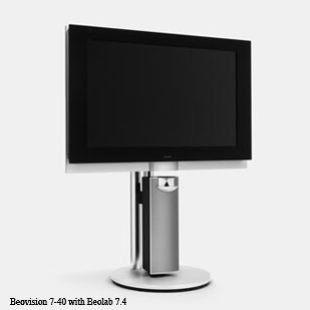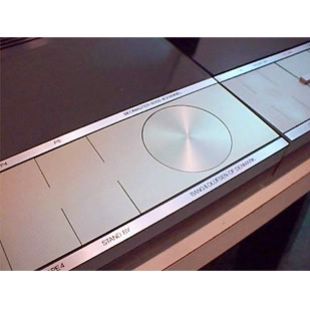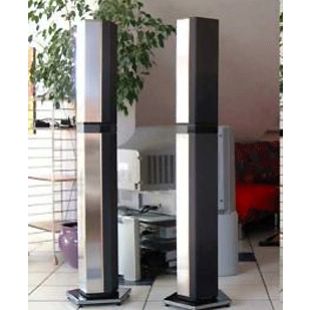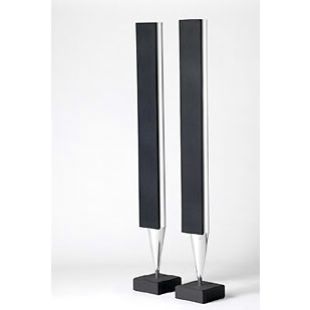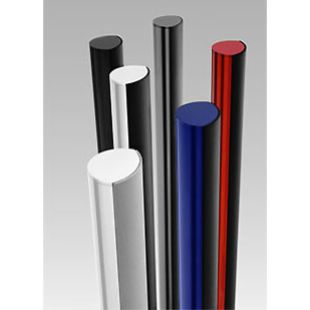There’s not much point in thinking about BeoLab 8000 in terms of watts, woofers or tweeters. There has never been loudspeakers that look like this – or so clear and rich a sound produced from such slender cabinets. BeoLab 8000 represents both the engineering skills as well as the design capabilities from Bang & Olufsen. Nobody has ever built a speaker with such little net volume, only 5,3 litres, with such an impressive sound.
As with all modern B&O speakers, the 8000s are active, meaning that each element has its own amplifier. In fact, each speaker holds two amplifier units. The biggest advantage in separating the amplifiers is that it enables the loudspeakers the ability to obtain maximum sound pressure from each element without distortion. The 8000s use the same reflective finish as the BeoLab Penta allowing them to blend well into their surroundings. By 2001 BeoLab 8000 became the most popular active speaker to date.
” When it comes to sound reproduction we believe there’s only one relevant parameter: How close can we come to the originally recorded sound. We feel an obligation not to disturb the intentions of the artist by adding unnatural elements to the acoustic image. Therefore all Bang & Olufsen loudspeakers share the same goal. They differ in size and shape and in terms of sound pressure level. But they are all developed to reproduce the natural, unaltered sound as closely as possible “ – Bang & Olufsen catalogue 2001 – 2002
There’s no great secret to creating good speakers – but they do (normally) have to be big. When it comes to speakers, one of the driving forces behind Bang & Olufsen’s product development is combining the most modern of technology with good aesthetics. The result is that the company avoids filling people’s houses with speakers the size of phone boxes; instead replacing them with elegant pillars or beautifully-designed wall-mounted units. Formed from a single piece of aluminium that eliminates the distortion problems of traditional speakers, BeoLab 8000 is mounted on a solid, cast iron base and will create the perfect effect wherever you choose to place it.
Placing the amplifiers directly into BeoLab 8000 not only improves its overall sound performance, it also makes it possible to reduce its size by up to a third. This active loudspeaker technology gives B&O the freedom to combine the purest of sounds with the simplest of shapes. A slim 132cm tall and just 10cm in diameter the graceful column of BeoLab 8000 will never dictate any furniture arrangements.
Why build amplifiers into the loudspeakers instead of keeping them separate?
Because you can reduce the size of the cabinet volume to one-third of the size of a conventional loudspeaker with the same sound capacity. The principle is called Active Loudspeakers, and what you get is a compact loudspeaker that can play at high volume without distortion or damage to its drive units.
Furthermore, when amplifier, treble and bass units are paired for the same task, they can be tailored to compensate for each other’s shortcomings. What you hear is music that sounds exactly like the instrument it originally came from (See active speakers).
Deep bass: how to make deep bass with a shallow cabinet
All loudspeakers, regardless of brand, size or construction, make sound by converting electric energy into acoustic energy. They push air in waves, which is what our ears pick up. To get high sound pressure, you need to move a lot of air.
You can use a very large diameter loudspeaker membrane, which moves a very short distance. Or (as Bang & Olufsen prefer), you can make the membrane “deeper”, in other words, make it move a greater distance with a smaller diameter. Imagine two balloons, one round and shaped like a ball, the other long and tubular. Both contain the same amount of air; it’s simply their shapes that are different. A side benefit to the deeper membrane is that it allows a smaller cabinet, with greater freedom as far as form and function are concerned. Since no two loudspeaker units have exactly the same physical characteristics, Bang & Olufsen calibrate them individually to make certain that the sound of each and every loudspeaker leaving our factory is identical.
By employing an active electronic crossover network with equalization, we’re able to adjust frequencies before they’re amplified. The signal from the sound source is shaped before distribution to the separate power amplifiers for bass and treble. In this way, the performance of the various components is “fine-tuned”, until they produce an ideal, harmonised output, which will be the same, no matter which BeoLab loudspeaker you feast your eyes upon.
The custom made driver units of a BeoLab loudspeaker feature extra-heavy membranes with longer movement, which help produce a deeper bass.
Adaptive Bass Linearisation
Adaptive Bass Linearisation (ABL) is a process patented by B&O and is incorporated in BeoLab loudspeakers. The idea is to use the surplus capacity in amplifiers and driver units, arising by normal listening levels, for a bass extension – a sound reproduction with more bass, than the loudspeaker otherwise would be able to produce.
The function is adaptive. This means that the loudspeaker adapts to the signal it receives. Loudspeaker drivers are therefore fully exploited, without suffering mechanical or electronic abuse, and the built in amplifiers are not subjected to signals would otherwise create an overload situation.
ABL gives stunning bass reproduction considering the size of the loudspeaker in which it is incorporated, under normal listening levels.
BeoLab 8000: active loudspeaker, 2 power amplifier modules, adaptive bass linearisation, aluminium cabinet and solid iron (11kg) base.
News: From January 2003, BeoLab 8000 was obtainable with new driver units giving extra bass at low levels. While not delivering as much as a BeoLab 2 (dedicated sub-woofer) the bass drivers with the newer BeoLab 8000 have a marked improvement over their predecessors. The upgrade involved new frequency equalization and improved ABL system. These improvements are mostly apparent at high volume levels. The changes are implemented form serial 16992475 onwards.
